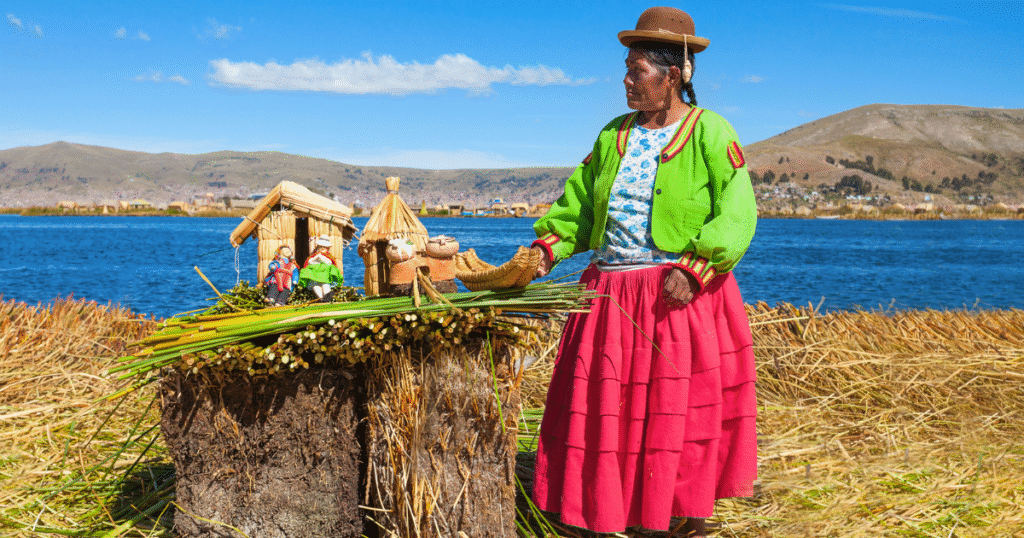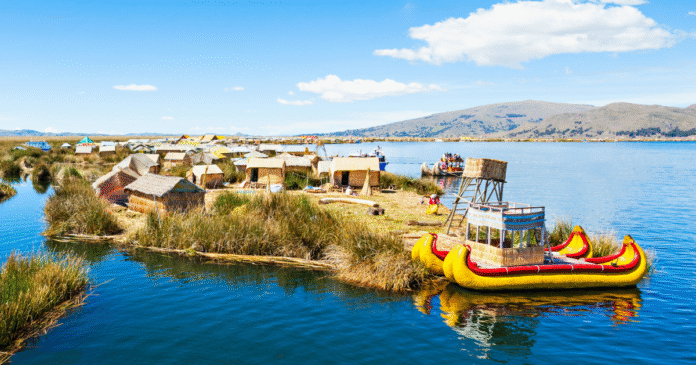**Life on Water: A Deep Dive into the Culture of the Uros People and Titicaca Floating Islands**Imagine a world where homes are built not on solid ground, but gently bobbing atop shimmering waters under an endless sky. Welcome to Lake Titicaca, nestled high in the Andes between Peru and Bolivia, where the Uros people have crafted a unique way of life for centuries. These remarkable floating islands, made entirely of totora reeds, are more than just stunning sights; they embody resilience, tradition, and an unbreakable bond with nature. Join us as we embark on an extraordinary journey to explore the vibrant culture of the Uros community—their age-old customs, intricate crafts, and deep spiritual ties to this majestic lake. Get ready to dive into a story that flows like water itself—fluid, rich in history, and filled with wonder!
Introduction to the Uros People and Titicaca floating islands
Nestled high in the Andes, Lake Titicaca is home to a remarkable sight: the floating islands of the Uros people. These unique islands, crafted from totora reeds, have fascinated travelers for centuries. Here, life dances on water—an intricate blend of tradition and resilience that captivates all who visit.
The Uros people’s connection to their environment runs deep. They embody a culture shaped by the rhythm of waves and whispers of wind. Each island tells a story rich with history and significance, inviting exploration into a way of life unlike any other. As we journey through this blog post, we’ll uncover what makes these floating islands more than just a tourist attraction; they are living symbols of survival amidst changing times. Join us as we dive into the heart of the Uros people and discover how they thrive on one of South America’s most enchanting lakes!
History and Significance of the Floating Islands
The Titicaca floating islands have a rich history that dates back centuries. The Uros people, believed to be one of the oldest civilizations in South America, constructed these unique islands as a refuge from their enemies on the mainland.
These artificial islands are crafted entirely from totora reeds, abundant in Lake Titicaca. This resourcefulness reflects their deep connection to their environment and showcases an innovative survival strategy.
Historically significant, the floating islands symbolize resilience and adaptability. They serve not only as homes but also as cultural hubs where traditions are preserved through generations.
The Uros people’s way of life is intricately tied to the water surrounding them. Their existence is a testament to human ingenuity in harmony with nature while maintaining distinct customs and languages separate from neighboring cultures.
Traditional Way of Life on the Floating Islands

Life on the Titicaca floating islands is a unique blend of tradition and adaptation. The Uros people have mastered an existence that harmonizes with the rhythms of water.
Daily routines revolve around the lake’s cycles. Fishing provides food, while crafting artisanal products fuels their economy. Children often learn these skills early, participating in both fishing and weaving activities.
Family structures are tight-knit. Community gatherings foster strong connections, allowing traditions to flourish through music and dance. Their vibrant attire reflects this communal spirit, often adorned with colors inspired by their surroundings.
Transportation relies on handcrafted reed boats called “balsas.” These vessels glide over the water effortlessly, showcasing the Uros’ deep understanding of their environment.
The essence of life here centers around sustainability. Every aspect—from housing to diet—reflects a commitment to preserving natural resources for future generations.
How are the Floating Islands Constructed?
The construction of the Titicaca floating islands is a remarkable feat of ingenuity. The Uros people rely primarily on totora reeds, which grow abundantly in the lake.
To create an island, they first gather large quantities of these reeds. Layers are then stacked and woven together to form a solid foundation that can support homes and gardens.
As time passes, the bottom layers decompose. To maintain buoyancy and stability, new reed layers are added regularly. This continuous process showcases their deep connection with nature.
Each island has its own unique design. Some may feature simple huts while others have communal areas for gatherings.
Living on water requires adaptability; thus, every aspect is meticulously planned to ensure sustainability in this vibrant ecosystem.
Cultural Practices and Beliefs of the Uros People
The Uros people weave a rich tapestry of cultural practices deeply tied to their environment. Water is not merely a backdrop; it’s integral to their identity. They believe that the lake, with its shimmering surface and abundant life, is sacred.
Rituals often revolve around the lake’s cycles. Offerings are made to Pachamama, or Mother Earth, honoring her gifts. These ceremonies strengthen community bonds and reinforce respect for nature.
Music and dance play vital roles in daily life too. Traditional songs echo tales of ancestors and celebrate life’s milestones. Brightly colored clothing represents both individual expression and cultural heritage.
Festivals bring everyone together, showcasing crafts like intricate reed boats and vibrant textiles. Through these art forms, stories are passed down generations—preserving history while adapting to modern influences.
Family ties remain strong among the Uros as they gather frequently for meals or celebrations on their floating islands—a testament to unity amidst waterborne living.
Tourism on the Floating Islands: Impact and Controversies
Tourism on the Titicaca floating islands is a double-edged sword. On one hand, it brings much-needed income to the Uros people. Visitors flock to experience their unique lifestyle and traditions.
However, this influx of tourists has sparked concerns about cultural erosion. The authenticity of traditional practices can be overshadowed by the desire to entertain visitors. Performances may feel staged, losing genuine connection over time.
Environmental issues also arise as more boats navigate these fragile waters. Increased waste and disturbances could threaten both the islands and their ecosystems.
Local leaders are aware of these challenges but face tough choices. Balancing economic benefits with cultural preservation remains a delicate task for the Uros community in an ever-changing world.
Preserving a Unique Way of Life: Challenges and Efforts
The Uros people face numerous challenges in preserving their unique lifestyle on the Titicaca floating islands. Climate change poses a significant threat, with rising water levels and unpredictable weather impacting the delicate balance of their environment.
As natural resources dwindle, traditional practices struggle to adapt. The reeds that form the foundation of their islands are becoming harder to harvest due to environmental degradation.
Efforts are underway to maintain this rich cultural heritage. Local organizations work tirelessly to promote sustainable tourism, hoping it will provide financial support while raising awareness about Uros traditions.
Education plays a crucial role as well. Elders pass down knowledge about crafting and living on the floating islands, ensuring younger generations appreciate their roots and skills.
Despite these efforts, external pressures from modernization continue to challenge their way of life, making preservation an ongoing battle for this resilient community.
Conclusion:
The Uros people and their unique lifestyle on the Titicaca floating islands offer a remarkable glimpse into a world where water is not just an element, but a way of life. Their resilience in maintaining traditions while adapting to modern influences highlights the intricate balance between preserving culture and embracing change.
Every aspect of their daily routine reflects an intimate relationship with Lake Titicaca. The construction of their homes from totora reeds demonstrates both ingenuity and resourcefulness that has been passed down through generations. Cultural practices rooted in ancient beliefs thrive amidst contemporary challenges, showcasing a vibrant heritage that continues to captivate visitors.
As tourism grows, it brings opportunities for engagement but also raises concerns about sustainability and cultural preservation. The Uros people are navigating these complexities with care, striving to keep their identity intact while sharing it with the outside world.
Life on these floating islands remains dynamic and ever-evolving. The fascinating connection between the Uros people and water serves as a reminder of humanity’s deep ties to nature—a relationship worthy of respect, understanding, and appreciation.


